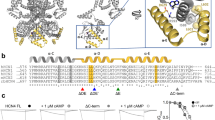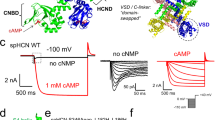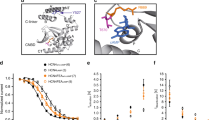Abstract
CYCLIC AMP acts as a second messenger in the modulation of several ion channels1–9 that are typically controlled by a phosphorylation process10. In cardiac pacemaker cells, adrenaline and acetylcholine regulate the hyperpolarization-activated current (if), but in opposite ways; this current is involved in the generation and modulation of pacemaker activity11. These actions are mediated by cAMP and underlie control of spontaneous rate by neurotransmitters12–17. Whether the cAMP modulation of if is mediated by channel phosphorylation is, however, still unknown. Here we investigate the action of cAMP on if in excised patches of cardiac pacemaker cells and find that cAMP activates if by a mechanism independent of phosphorylation, involving a direct interaction with the channels at their cytoplasmic side. Cyclic AMP activates if by shifting its activation curve to more positive voltages, in agreement with whole-cell results. This is the first evidence of an ion channel whose gating is dually regulated by voltage and direct cAMP binding.
This is a preview of subscription content, access via your institution
Access options
Subscribe to this journal
Receive 51 print issues and online access
$199.00 per year
only $3.90 per issue
Buy this article
- Purchase on Springer Link
- Instant access to full article PDF
Prices may be subject to local taxes which are calculated during checkout
Similar content being viewed by others
References
Tsien, R. W. Advances in Cyclic Nucleotide Research 8, 363–420 (1977).
Reuter, H. Nature 301, 569–574 (1983).
Osterrieder, W. et al. Nature 298, 576–578 (1982).
de Peyer, J. E., Cachelin, A. B., Levitan, I. B. & Reuter, H. Proc. natn. Acad. Sci. U.S.A. 79, 4207–4211 (1982).
Shuster, M. J., Camardo, J. S., Siegelbaum, S. A. & Kandel, E. R. Nature 313, 392–395 (1985).
Ewald, D. A., Williams, A. & Levitan, I. B. Nature 315, 503–506 (1985).
Walsh, K. B. & Kass, R. S. Science 242, 67–69 (1988).
Li, M. et al. Nature 331, 358–360 (1988).
Kume, H., Takai, A., Tokuno, H. & Tomita, T. Nature 341, 152–154 (1989).
Levitan, I. B. J. Memb. Biol. 87, 177–190 (1985).
DiFrancesco, D. Prog. Biophys. molec. Biol. 6, 163–183 (1985).
Tsien, R. W. J. gen. Physiol. 64, 293–319 (1974).
Brown, H. F., DiFrancesco, D. & Noble, S. J. Nature 280, 235–236 (1979).
DiFrancesco, D., Ferroni, A., Mazzanti, M. & Tromba, C. J. Physiol., Lond. 377, 61–88 (1986).
DiFrancesco, D. Nature 324, 470–473 (1986).
DiFrancesco, D. & Tromba, C. J. Physiol., Lond. 405, 493–510 (1988).
DiFrancesco, D., Ducouret, P. & Robinson, R. B. Science 243, 669–671 (1989).
Yatani, A., Okabe, K., Codina, J., Birnbaumer, A. & Brown, A. M. Science 249, 1163–1166 (1990).
Chang, F., Rosen, M., Tromba, C., Cohen, I. S. & DiFrancesco, D. Biophys. J. 57, 141a (1990).
Eckstein, F., Cassel, D., Levkovitz, H., Lowe, M. & Selinger, Z. J. biol. Chem. 254, 9829–9834 (1979).
DiFrancesco, D. & Tromba, C. J. Physiol., Lond. 405, 477–491 (1988).
Teresaki, W. L. & Brooker, G. J. biol. Chem. 252, 1041–1050 (1977).
Fesenko, E. E., Kolesnikov, S. S. & Lyubarsky, A. L. Nature 313, 310–313 (1984).
Haynes, L. W. & Yau, K. W. Nature 317, 61–64 (1986).
Johnson, E. C. et al. Nature 324, 468–470 (1986).
Nakamura, T. & Gold, G. H. Nature 325, 442–444 (1987).
Dhallan, R. S., Yau, K., Schrader, K. & Reed, R. R. Nature 347, 184–187 (1990).
Bobker, D. & Williams, J. T. Neuron 2, 1535–1540 (1989).
Pape, H-C. & McCormick, D. A. Nature 340, 715–718 (1989).
Demaille, J. G., Peters, K. A. & Fischer, E. H. Biochemistry 16, 3080–3086 (1977).
Author information
Authors and Affiliations
Rights and permissions
About this article
Cite this article
DiFrancesco, D., Tortora, P. Direct activation of cardiac pacemaker channels by intracellular cyclic AMP. Nature 351, 145–147 (1991). https://doi.org/10.1038/351145a0
Received:
Accepted:
Issue Date:
DOI: https://doi.org/10.1038/351145a0
This article is cited by
-
A high affinity switch for cAMP in the HCN pacemaker channels
Nature Communications (2024)
-
Direct regulation of the voltage sensor of HCN channels by membrane lipid compartmentalization
Nature Communications (2023)
-
Physiological effects of ivabradine in heart failure and beyond
Molecular and Cellular Biochemistry (2023)
-
Investigation of hyperpolarization-activated cyclic nucleotide-gated (HCN) channels in vitro inflammation model at molecular level
Molecular and Cellular Biochemistry (2023)
-
Functional and structural characterization of interactions between opposite subunits in HCN pacemaker channels
Communications Biology (2022)
Comments
By submitting a comment you agree to abide by our Terms and Community Guidelines. If you find something abusive or that does not comply with our terms or guidelines please flag it as inappropriate.



